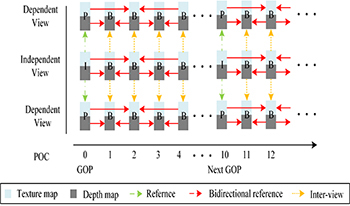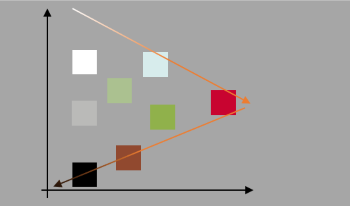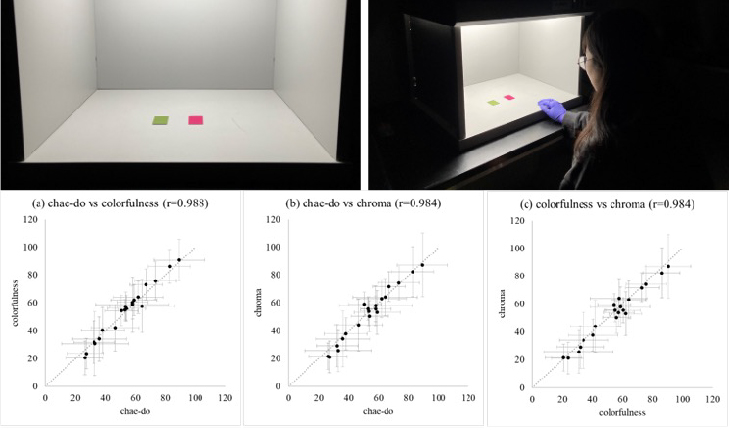
The format of multi-view plus depth (MVD) is introduced in 3D-HEVC for improving coding efficiency. However, as the number of viewpoints increases, the computational complexity increases dramatically. To overcome this issue, a method based on RD-cost Bayesian Decision (RDBD) for 3D-HEVC fast depth map inter coding is proposed in this paper, including coding unit (CU) early termination and SKIP/DIS decision. First, an offline training model with the minimum risk Bayesian decision rule is used to predict optimal CU size in depth map. Then, a minimum error rate Bayesian decision rule is proposed to determine whether SKIP or DIS is the best mode and ignores the rate distortion optimization (RDO) process of other modes. Experimental results show that, with the proposed algorithm, 45.7% depth map encoding time saving is achieved compared to the original 3D-HEVC, and outperforms state-of-the-art fast inter coding methods for 3D-HEVC.

Pictorial research can rely on computational or human annotations. Computational annotations offer scalability, facilitating so-called distant-viewing studies. On the other hand, human annotations provide insights into individual differences, judgments of subjective nature. In this study, we demonstrate the difference in objective and subjective human annotations in two pictorial research studies: one focusing on Avercamp’s perspective choices and the other on Rembrandt’s compositional choices. In the first experiment, we investigated perspective handling by the Dutch painter Hendrick Avercamp. Using visual annotations of human figures and horizons, we could reconstruct the virtual viewpoint from where Avercamp depicted his landscapes. Results revealed an interesting trend: with increasing age, Avercamp lowered his viewpoint. In the second experiment, we studied the compositional choice that Rembrandt van Rijn made in Syndics of the Drapers’ Guild. Based on imaging studies it is known that Rembrandt doubted where to place the servant, and we let 100 annotators make the same choice. Subjective data was in line with evidence from imaging studies. Aside from having their own merit, the two experiments demonstrate two distinctive ways of performing pictorial research, one that concerns the picture alone (objective) and one that concerns the relation between the picture and the viewer (subjective).

Vividness and Depth are widely used in image and textile industry. And these scales were derived from one-dimensional scales of CIELAB L* and C*ab. However, these scales are limited to relative scales with a reference white, which makes it difficult for them to adapt to the variation in the world. This paper has introduced an experiment that focuses on assessing the wide range of luminance levels in a visual context, ranging from 10 cd/m2 to 10000 cd/m2. The experiment employed a method called magnitude estimation to gauge the perception of Vividness, Depth, Whiteness, and Blackness scales. The judgments were obtained through 10 observer x 40 NCS Sample x 4 lux level x 4 scales x 1.1 (10% repeat set), resulting in a total of 7040 assessments. This article mainly introduces the development of vividness and depth scales using combinations of relative scales, absolute scales, and the mixture scales like CAM16-UCS.

In this study, the relationships between chae-do, the commonly used Korean terminology to describe chromatic attributes, CIE definition for colorfulness, Munsell definition for chroma, Berns’ definition for CIELAB based vividness and depth are investigated. Although only the definitions were presented, without corresponding terminologies, the observers’ responses showed that chae-do is understood very similarly to the definitions of CIE colorfulness and Munsell chroma. Responses for the definitions of vividness and depth also showed high correlation with Berns’ CIELAB based vividness and depth predictions, which shows that definitions were well understood. No correlations were found between the definition of CIE colorfulness and the definition of vividness, which shows that the definition of vividness is understood differently to the definition of colorfulness. Comparing the response with color appearance model predictions, the responses showed good correlation with the predictions. Especially, colorfulness definition responses showed the highest coefficient correlation with CIELAB-based Berns’ depth prediction, implying the possibility of colorfulness predictor modification for better prediction. The findings can be further investigated to observers from other non-English speaking countries and collect meaningful cross-cultural color appearance data.